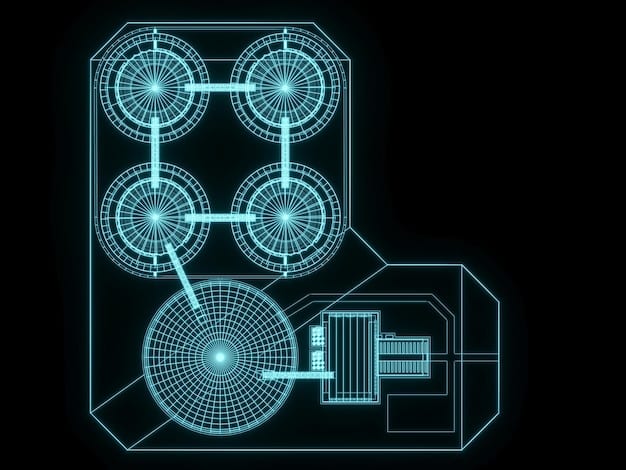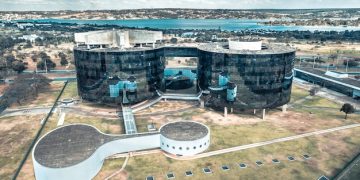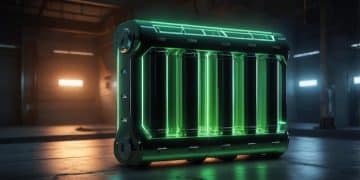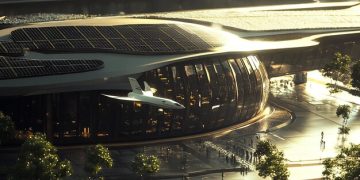Are Small Modular Reactors the Future of US Energy by 2027?

Small Modular Reactors (SMRs) represent a promising solution for US energy needs by 2027 due to their potential for enhanced safety, reduced capital costs, and flexible deployment, although regulatory hurdles, economic competitiveness, and public acceptance remain critical factors.
The quest for cleaner, more efficient energy sources has intensified, especially with the growing urgency to address climate change and modernize aging infrastructure. Could Small Modular Reactors (SMRs) a Viable Solution for US Energy Needs by 2027? Let’s explore the potential and challenges of SMRs in reshaping the US energy landscape.
Small Modular Reactors: An Overview
Small Modular Reactors (SMRs) are gaining traction as a potential game-changer in the nuclear energy sector. These reactors, smaller in size and modular in design, offer several advantages over traditional large-scale nuclear power plants.
But what exactly are SMRs, and why are they considered a promising solution for the future of energy?
Defining Small Modular Reactors
SMRs are nuclear fission reactors that are significantly smaller than traditional reactors, typically generating up to 300 MW of electricity. Their modular design allows for factory fabrication and on-site assembly, reducing construction time and costs.
Key Characteristics of SMRs
- Smaller Size: SMRs have a significantly smaller footprint compared to traditional nuclear reactors.
- Modular Design: Their modularity allows for scalability and easier integration into existing power grids.
- Enhanced Safety Features: SMRs often incorporate passive safety systems, reducing the risk of accidents.
- Reduced Capital Costs: Factory fabrication and modular construction can lower upfront capital costs.
The appeal of SMRs lies in their potential to provide a more flexible, cost-effective, and safer nuclear energy solution. As the US seeks to modernize its energy infrastructure and reduce carbon emissions, SMRs offer a pathway to achieving these goals.
The Potential Benefits of SMRs for the US
The integration of Small Modular Reactors (SMRs) into the US energy infrastructure could yield numerous benefits, ranging from economic growth to enhanced energy security.
Let’s explore the specific advantages that SMRs could bring to the United States.

Economic Opportunities
The deployment of SMRs can stimulate economic growth by creating jobs in manufacturing, construction, and operation. The modular nature of SMRs also allows for a more distributed energy supply, reducing transmission costs and improving grid resilience.
Environmental Advantages
Nuclear energy, including SMRs, is a low-carbon energy source that can help reduce greenhouse gas emissions. By replacing fossil fuel-based power plants with SMRs, the US can make significant strides in achieving its climate goals.
Energy Security
SMRs can enhance energy security by providing a reliable and domestically sourced energy supply. Unlike fossil fuels, nuclear fuel can be stockpiled, reducing dependence on foreign energy sources.
The potential benefits of SMRs extend beyond mere energy production. They represent an opportunity to revitalize the US economy, protect the environment, and strengthen national security. As such, investing in SMR technology could be a strategic move for the United States.
Challenges Facing SMR Deployment by 2027
While Small Modular Reactors (SMRs) offer significant potential as a clean energy solution, their widespread deployment in the US by 2027 faces several challenges.
Addressing these challenges will be crucial to realizing the full potential of SMRs.
Regulatory Hurdles
The regulatory framework for nuclear energy in the US is complex and time-consuming. SMR developers must navigate a rigorous licensing process with the Nuclear Regulatory Commission (NRC), which can delay deployment timelines.
Economic Competitiveness
SMRs must be economically competitive with other energy sources, including natural gas, solar, and wind. High upfront capital costs and uncertainties about long-term operational costs can hinder their adoption.
Public Acceptance
Public perception of nuclear energy can be a barrier to SMR deployment. Addressing concerns about safety, waste disposal, and security is essential to gaining public support.
Overcoming these challenges will require a concerted effort from policymakers, industry stakeholders, and the public. Streamlining the regulatory process, reducing costs through innovation, and engaging in open and transparent communication are all critical steps.
Technological Advancements in SMRs
Advancements in technology are continuously improving the safety, efficiency, and cost-effectiveness of Small Modular Reactors (SMRs).
These innovations are key to making SMRs a viable energy solution for the US.
Passive Safety Systems
Many SMR designs incorporate passive safety systems that rely on natural forces like gravity and convection to prevent accidents. These systems reduce the need for human intervention and external power sources, enhancing safety.
Advanced Fuel Technologies
Advanced fuel designs can improve reactor performance, increase fuel efficiency, and reduce waste. These technologies are being developed to make SMRs more sustainable and environmentally friendly.
Digitalization and Automation
Digitalization and automation are transforming the operation and maintenance of SMRs. These technologies can improve efficiency, reduce costs, and enhance safety by providing real-time monitoring and control.
These technological advancements are paving the way for a new generation of nuclear reactors that are safer, more efficient, and more cost-effective. As SMR technology continues to evolve, its potential to address the US energy needs will only grow.

The Role of Government and Policy in SMR Deployment
Government policies and support play a crucial role in the deployment of Small Modular Reactors (SMRs) in the US.
Policy decisions can either accelerate or hinder the adoption of SMR technology.
Financial Incentives
Government incentives, such as tax credits, subsidies, and loan guarantees, can help reduce the financial risks associated with SMR development and deployment. These incentives can attract private investment and accelerate the commercialization of SMR technology.
Regulatory Framework
A clear and efficient regulatory framework is essential for SMR deployment. Streamlining the licensing process and establishing predictable regulatory standards can reduce uncertainty and encourage investment.
Research and Development
Government funding for research and development can drive innovation and improve SMR technology. Supporting research into advanced materials, fuel designs, and safety systems can enhance the performance and cost-effectiveness of SMRs.
- Funding for pilot projects
- Support for workforce development
- Facilitating international cooperation
Government support is not just about financial assistance; it’s about creating an environment that fosters innovation, reduces risk, and encourages the adoption of cleaner, more sustainable energy technologies. The US government’s commitment to SMRs will be a key factor in determining their success.
SMRs and the US Energy Mix by 2027: A Realistic Outlook
Considering the current state of technology, regulatory processes, and economic factors, what is a realistic outlook for the role of Small Modular Reactors (SMRs) in the US energy mix by 2027?
While significant progress has been made, several challenges remain.
Near-Term Prospects
It is unlikely that SMRs will make a significant contribution to the US energy supply by 2027. While several projects are underway, regulatory hurdles and construction timelines mean that few, if any, SMRs will be operational by then.
Longer-Term Potential
Looking beyond 2027, SMRs have the potential to play a more significant role in the US energy mix. As technology matures, regulatory processes become more streamlined, and costs decrease, SMRs could become a more attractive option for utilities and energy providers.
Realistic Expectations
A realistic outlook for SMRs involves acknowledging the challenges and focusing on long-term potential. By investing in research and development, streamlining regulatory processes, and engaging in open and transparent communication, the US can pave the way for SMRs to play a meaningful role in the future of energy.
The integration of SMRs into the US energy mix is a complex and multifaceted undertaking. By setting realistic expectations and focusing on long-term goals, the US can harness the potential of SMRs to create a cleaner, more secure, and more sustainable energy future.
| Key Aspect | Brief Description |
|---|---|
| 💡 Definition of SMRs | Smaller, modular reactors with enhanced safety and lower costs. |
| 🌱 Environmental Benefits | Low-carbon energy source, reduced greenhouse gas emissions. |
| 🚧 Challenges by 2027 | Regulatory hurdles, economic competitiveness, public acceptance. |
| 🛡️ Safety Advancements | Passive safety systems reduce accident risks. |
FAQ
▼
The modular design and smaller size of SMRs allow for factory fabrication and on-site assembly, reducing construction time and costs compared to traditional large-scale nuclear power plants.
▼
SMRs are a low-carbon energy source, helping to reduce greenhouse gas emissions, which contributes significantly to mitigating climate change and promoting a cleaner environment.
▼
Key challenges include navigating complex regulatory processes, ensuring economic competitiveness with other energy sources, and addressing public concerns about nuclear energy safety.
▼
Governments can support SMR development through financial incentives, streamlined regulations, and funding for research and development, which are vital for advancing SMR technology.
▼
It is unlikely SMRs will significantly impact the US energy mix by 2027 due to regulatory constraints and construction timelines, pointing to a need for long-term investment in the sector.
Conclusion
In conclusion, while Small Modular Reactors (SMRs) a Viable Solution for US Energy Needs by 2027? they hold significant promise for the future, their widespread deployment faces considerable challenges. Overcoming these hurdles will require a concerted effort from policymakers, industry stakeholders, and the public to unlock their full potential and reshape the US energy landscape.





